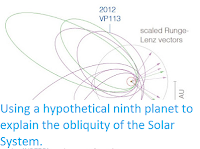Trans-Neptunian Object A/2019 K6 (PANSTARRS) will make its closest approach to the
Earth on Friday 1 May 2020, reaching a distance of 2.93
AU from the Earth (293%
of the distance between the Earth and the Sun, or 438 322 000 km). At
this distance the comet will be not naked eye visible, having a
magnitude of 13.6, (roughly the same as Uranus' moon Titania), in the Constellation of Libra, which is better observed from
the Southern Hemisphere at this time of year.
A/2019 K6 (PANSTARRS) imaged from the Brixiis Observatory in Kruibeke, Belgium on 27 June 2019. Composite image made up of 30 two minute exposures. The A/2019 K6 is the point at the centre of the image indicated by the two lines, the more elongate objects are stars that have moved over the course of the exposure. Erik Bryssinck/Seiichi Yoshida's Comet Page.
A/2019 K6 (PANSTARRS) was discovered on 31 May 2019 by the University of Hawaii's PANSTARRS telescope.
The name C/2016 M1 (PANSTARRS) implies that it is an asteroid
(A/) (the body is on a comet-like orbit, but has shown no sign of cometary activity), that it was the sixth comet'like body (comet 6) discovered in
the second half of May 2019 (period 2019 K) and that it was
discovered by the PANSTARRS telescope.
The orbit and current position of A/2019 K6 (PANSTARRS). In The Sky.
A/2019 K6 (PANSTARRS) has an estimated orbital period of 61 602 years and a
highly eccentric
orbit tilted at an angle of 132° to the plain of the Solar System, that
brings it to 3.93 AU from the Sun at perihelion (393% of the distance
between the Earth and the Sun; between the orbits of the planets Mars and Jupiter);
to 3116 AU from the Sun at aphelion (3116 times as far from the Sun as
the Earth or 103 times as far from the Sun as the planet Neptune), between the outer Kuiper Belt and the inner Oort Cloud. As an object which spends most of its time outside of the orbit of the planet Neptune, and shows no sign of cometary activity when at perihelion, A/2019 K6 (PANSTARRS) is classified as a Trans-Neptunian Object.
See also...
Follow Sciency Thoughts on Facebook.







































